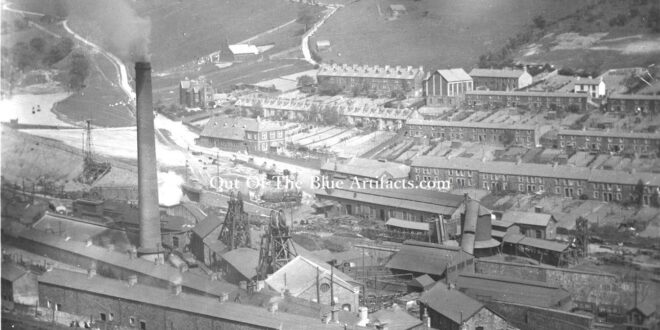The Cwmtillery Colliery.
The Cwmtillery Colliery, image taken from West Bank about 1911.
Points of interest – The colliery and grounds in the center of the image with the company cottages either side of the valley once owned by the South Wales Colliery Company and constructed for the large workforce. On the left is the colliery feeder, flight buckets can be seen travelling up and down the valley and their standards. To the left of the top of the chimney is the path to the reservoir and by the side of it is the tram line from the Hendre Gwyndir Level and levels from further up in the valley. This tram line can be seen going down and through the grounds of the colliery. To the right of the top of the chimney is the large house known as Lake Villa’s, built by the Messrs J. Lancaster Company to house the management. Above the Lake Villa’s is St Paul’s Chapel, below is Colliers Hall. The large building in the distance (center top right) is the Bible Christian Chapel.
The Bible Christian Chapel, Cwmtillery – The Red Brick Chapel.
Built in 1871 and opened by Mr Joseph Wallace, Manager of the Cwmtillery Colliery, on behalf of Mr Lawrence Heyworth, chairman of the South Wales Colliery Company, the proceedings were commenced by Rev. J. Jeffrey (Pontypool) and Rev. R. P. Tabb (Newport).
In May 1896 the chapel that was getting too small for the population and was demolished, the cost of the new one was estimated to be about £1,500-£1,600, it was built on the site of the original chapel, the architect was Mr V. H. Culliford of Newton Abbot, the contract was given to Mr J. Prout of Barry. The minister was Rev. S. Eva.
The building of the new chapel was started on Monday 22nd of June 1896, and it was estimated to be completed before December. During the building operations the services was held in a building in the disused Brickyard at Woodland Terrace. The work was held up as of the builder Mr J. Prout going bankrupt halfway through the course of erection. The chapel was later completed by the workmen under the supervision of Mr Southcombe.
The new chapel was completed and opened in April 1907, it was of semi-gothic style, built of Severnside bricks with white brick buttresses and string courses seating is pitch pine and a slate roof, with cathedral windows. The accommodation was for about 350, underneath the chapel was a schoolroom, four classrooms and a furnace house, the school portion was built with the stone taken from the old building. The final cost of the new building was £1,500.
 Out Of The Blue Artifacts A Library of a lifetime of collecting
Out Of The Blue Artifacts A Library of a lifetime of collecting
